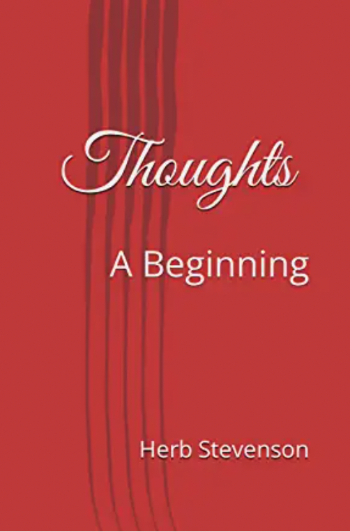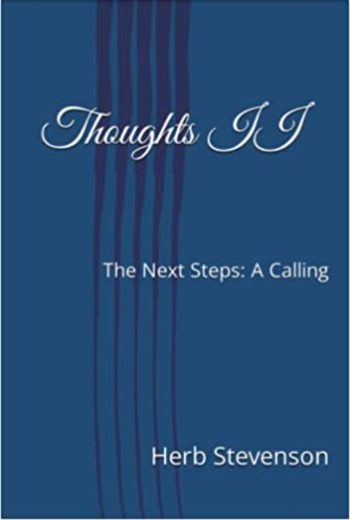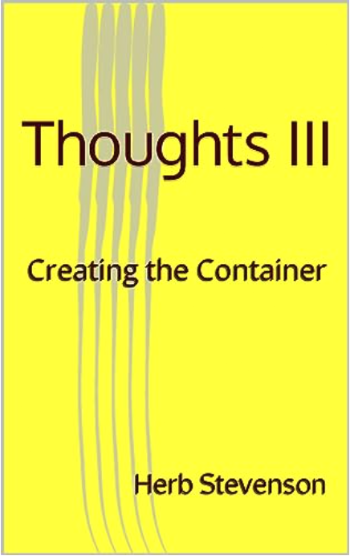

A book by Herb Stevenson, Volume 1. Learn more on Amazon.
Thoughts II:
The Next Step: A Calling

Volume 2 of 3. Learn more on Amazon.
Thoughts III:
Creating The Container

Volume 3 of 3. Learn more on Amazon.
To Lead
Read the article about training with Herb Stevenson in ALN Magazine.
See the article...
PERSONAL CHANGE ASSESSMENT
The Four Laws of Change
Cross culturally, to enhance change effectiveness the four laws of change were used to assess the readiness for change.
Change comes from within. This means that change will always come from within the individual, from within the group, and/or from within the organization. Change is a relationship with your self. Ideally, the change will be like a pebble thrown into a lake where the change ripples from within all of these configurations
Permanent change requires a vision. This means that unless we hold a clear and/or compelling picture of what is the change that needs to occur, the initial insight or energy or reason for changing fades into the background until triggered by the next difficult reminder and/or painful event.
A great healing/learning must occur. Healing and learning are closely aligned in indigenous cultures. Often, relationships with self or others are healed upon learning new information or by developing different perceptions or by taking the time to help our self or others understand a situation differently. In short, change is often accompanied by a personal insight or group awareness created by waiting in the silence. Hence, for an individual, it could be an epiphany that suddenly sheds light on a problem; or for a family, it could be an insight that they are actually creating most of their problems by how they behave towards each other.
A healing force/forest must be present. So as to make any change permanent, the person needs to share it with others, who in turn will learn to support them in the change. As such, change requires a partnership between those initiating the change and those participating in the change. This means that any change to be permanent must have the support of the larger community. This support is a partnership for life. For an individual, it could mean that the insight or vision is shared with family and friends and time is spent allowing them to understand and learn to see the value of the change. Regardless, the level of success will be directly proportional with the ability to communicate the change and to build support for it.
Describe the change that you seek for yourself.
Assessing Your Readiness for Change
Below are 25 questions. You should answer the questions from your own point of view. You try to simply respond without too much thinking and resist the temptation to give an expected or the-way-it-ought-to-be answer. It is meant to give you a snapshot of how things are now, not how they'll be when everything falls into place.
Answer each question with the following numbers:
4 = The statement is definitely true or accurate.
3 = The statement is largely accurate or mostly true.
2 = The statement is only partly true or accurate.
1 = This is only occasionally (but not very often) true 0 = The statement is utterly false.
1.___ I think that the change in question is a necessary one.
2.___ Given my situation, the change I seek represents how I can become more fully who I am.
3.___ I am committed to the change.
4.___ My family and friends are aware of the change I seek
5.___ ....and, generally, my family and friends support the change
6.___ The details of my change are being communicated to those who will be affected as quickly as it is practical to do so.
7.___ Family and friends are able to tell me about their concerns and questions about the change without my over-reacting.
8.___ And those concerns and questions have, thus far, been responded to in a pretty honest and timely way.
9.___ There aren’t a lot of old scars or unresolved issues around my change.
10.___ I have a history of handling change fairly well.
11.___ I have a history of doing what I say I will do.
12.___ ...and of saying what I am going to do before I do it.
13.___ I think that if this is what I want to do, that I can pull it off......... successfully.
14.___ Generally, my decisions are made in a timely fashion.
15.___ When I change, I support others with patience and understanding while they get used to the new way that I am.
16.___ When faced with new and challenging situations, I let go of the old way of doing things and apply how I am now.
17.___ It is safe to take an "intelligent" risk with me by saying what is so when it is so without blame or judgement.
18.___ There is a pretty widely understood vision or shared understanding of whom I am and what I am seeking to become and/or to accomplish.
19.___ Even though I am making the change, we (my family and friends) feel like we're all in this thing together.
20.___ My commitment to myself is as high and unwavering.
21.___ Although the pace and extent of change I am seeking may be great, it is also workable.
22.___ Generally, I practice what I preach.
23.___ Basically, there is no disagreement about my desire to change.
24.___ Generally, I show an awareness of and concern for how my change will affect others in my life.
25.___ People...family and friends... generally understand how things will be different when the change is finished.
_____ TOTAL SCORE
Evaluating the Results
The highest score is 100. The higher the score, the more you and your family and friends are ready for the change in question. Specific questions that have low scores are areas that could use some additional thought and/or work.
Integration
List your reactions to the questionnaire at this moment. Pay attention to whether your reaction feels familiar. If so, how is it familiar.
Deepening the Process
To get an idea of the general areas that might need more work, tally the scores for each of the Laws of Change. The lower the cumulative score for each of the four laws, the more work that needs to be done in that particular area. For example, if it is clear that a compelling picture or vision has not been developed and integrated, then the change initiative will likely fail. Knowing this area is deficient, you can take corrective action.
Change Comes from Within: ___1___2___3___6___20___22 Total_____of 24
If applicable, list some actions that you can take to raise this score
Permanent Change Requires a Vision: ___13___14___16___18___21___24 Total_____of 24
If applicable, list some actions that you can take to raise this score
A Great Healing/Learning Must Occur: ___7___9___10___12___15___23 Total_____of 24
If applicable, list some actions that you can take to raise this score
A Healing Forest/Force Must be Present: ___4___5___8___11___17___19___25 Total_____of 28
If applicable, list some actions that you can take to raise this score
Evaluating the Process
To get a deeper sense of your internal process related to change, the following questions may provide some insights to yourself and to the change process.
Generally, describe what you are feeling/noticing/thinking at this moment about the desired change?
Which questions caused a tinge of pain or discomfort? Describe the discomfort that occurred?
Generally, describe which of the laws of change requires more time and effort for your change to be successful?
Describe what you are Now willing to do to make the desired change.
We Appreciate Your Feedback
Please let us know if you found this article interesting or useful. We will not submit this information to any third parties.

